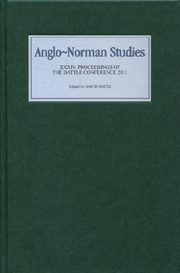Book contents
- Frontmatter
- Contents
- LIST OF ILLUSTRATIONS AND TABLES
- EDITOR'S PREFACE
- ABBREVIATIONS
- Mints and Money in Norman England
- Literate Sociability and Historical Writing in Later Twelfth-Century England
- The Archbishopric of Canterbury and the So-called Introduction of Knight-Service into England
- Lastingham and the Architecture of the Benedictine Revival in Northumbria
- ‘Lanfranc of Bec’ and Berengar of Tours
- The Invention of the Manor in Norman England
- Herbert Losinga's Trip to Rome and the Bishopric of Bury St Edmunds
- Le récit de Geoffroi Malaterra ou la légitimation de Roger, Grand Comte de Sicile
- The Two Deaths of William Longsword: Wace, William of Malmesbury, and the Norman Past
- The Beasts Who Talk on the Bayeux Embroidery: The Fables Revisited
- The Piety of Earl Godwine
The Invention of the Manor in Norman England
Published online by Cambridge University Press: 05 April 2013
- Frontmatter
- Contents
- LIST OF ILLUSTRATIONS AND TABLES
- EDITOR'S PREFACE
- ABBREVIATIONS
- Mints and Money in Norman England
- Literate Sociability and Historical Writing in Later Twelfth-Century England
- The Archbishopric of Canterbury and the So-called Introduction of Knight-Service into England
- Lastingham and the Architecture of the Benedictine Revival in Northumbria
- ‘Lanfranc of Bec’ and Berengar of Tours
- The Invention of the Manor in Norman England
- Herbert Losinga's Trip to Rome and the Bishopric of Bury St Edmunds
- Le récit de Geoffroi Malaterra ou la légitimation de Roger, Grand Comte de Sicile
- The Two Deaths of William Longsword: Wace, William of Malmesbury, and the Norman Past
- The Beasts Who Talk on the Bayeux Embroidery: The Fables Revisited
- The Piety of Earl Godwine
Summary
There is more in this article about the Latin word manerium than about the thing it described, the manor, but I shall be using the early history of the word as a way of getting at what was in people's heads when they wrote manerium in the later eleventh century and at what realities they saw, or thought they saw, on the ground. Words, concepts and things are not the same, as Susan Reynolds has taught us, and historians are well advised to begin by separating them. I would thus gloss David Bates's injunction that anyone intent on comparing pre- and post-Conquest society should ‘concentrate more on phenomena than on language, since much of the latter was substantially new after 1066’. Archaeology apart, we can only approach historical phenomena through the words in which they were described at the time, so that understanding what the language meant has to come first. Even more important, language is itself a historical phenomenon which demands serious attention, not least when used with deliberation by the new ruling elite of England after 1066.
Historians have never shrunk from placing the origins of the manor in the period before the word came into use, nor indeed from recognizing as manors landed estates of a broadly similar character in much earlier periods and quite different locales. Historical writing about the central Middle Ages in England could hardly do without the idea of the manor: archaeologists concerned with changing settlement patterns, historians of domestic buildings discussing ‘manor houses’, economic historians – all proceed on the basis that ‘the manor’ meant something, and that it meant much the same thing across the period.
- Type
- Chapter
- Information
- Anglo-Norman Studies 34Proceedings of the Battle Conference 2011, pp. 123 - 150Publisher: Boydell & BrewerPrint publication year: 2012

